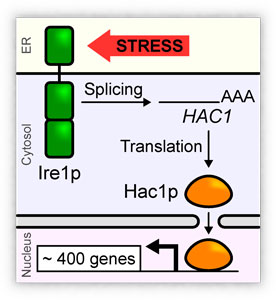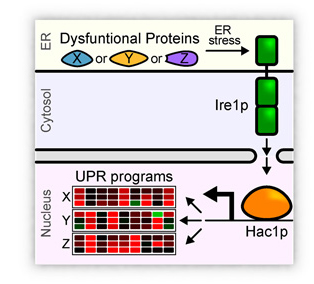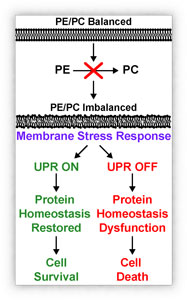CURRENT RESEARCH
Lipid regulation in eukaryotesHundreds of distinct lipids, of varying concentrations, assemble to form biological membranes. The most abundant, phospholipids, varies according to head group structures, acyl chain length and double bounds. In eukaryotes, lipid compositions can differ widely among organelles. In most cases, the biological significance of these differences remains unclear The complex organization of cellular membranes suggests the need of sophisticated homeostatic regulatory mechanisms. Links were made with an endoplasmic reticulum (ER) stress pathway called the unfolded protein response (UPR). The UPR activation is required to ease the damaging effects of ER stress. Yeast relies exclusively on the Ire1p pathway while metazoans have two additional UPR outputs. This characteristic makes budding yeast a very attractive model organism since its sole UPR pathway can be easily manipulated. Normally, this response leads to ER homeostasis by facilitating refolding of proteins and enhancing recognition and degradation of misfolded proteins. Meant to be temporary, the UPR must be deactivated to avoid cell death due to chronic ER stress. Many diseases, such as Alzheimer, Parkinson, diabetes mellitus type 2, and hepatic steatosis, have been linked to recurrent ER stress. |

|
The unfolded protein response supports cellular robustness as a broad-spectrum compensatory pathwayWe designed a unique strategy to study the effects of genetically defined ER stress with the UPR muted in budding yeast. The data demonstrated that the UPR is essential to compensate for diverse defects. Using DNA microarray analysis, it illustrated that the transcriptional profiling of UPR activated cells exhibit differential gene expression depending on the stress. This study supports the major mechanism role of the UPR in maintaining systems robustness. Currently, we are focusing on the UPR activation and its specific response to lipid disequilibrium. |

|
The membrane stress responseHundreds of distinct lipids, of varying concentrations, assemble to form biological membranes. In eukaryotes, lipid compositions can differ widely among organelles. Accordingly, lipid homeostasis is critical as disequilibrium can lead to disease states. We established a model reflecting lipid imbalance and we focused on how cells respond to and cope with phosphatidylcholine/ phosphatidylethanolamine (PC/PE) disequilibrium. Cho2p and Opi3p are required for the synthesis of de novo PC from PE in budding yeast. Using lipidomic, genomic, and proteomic technologies, the data revealed that the adaptive cells responded by remodeling the protein homeostasis network without restoring lipid composition that we termed membrane stress response (MSR). To validate its physiological significance, we analyzed the UPR, a critical facet of the MSR. The data showed that the UPR rescues cells during lipid disequilibrium by compensating for protein biogenesis and quality control deficiencies. We are currently studying different aspects of the MSR related to metabolic diseases. We designed a unique strategy to study the effects of genetically defined ER stress with the UPR muted in budding yeast. The data demonstrated that the UPR is essential to compensate for diverse defects. Using DNA microarray analysis, it illustrated that the transcriptional profiling of UPR activated cells exhibit differential gene expression depending on the stress. This study supports the major mechanism role of the UPR in maintaining systems robustness. Currently, we are focusing on the UPR activation and its specific response to lipid disequilibrium. |
 |
© Copyright 2013. All rights reserved

follow us: